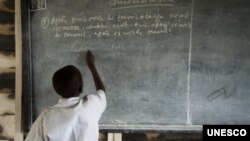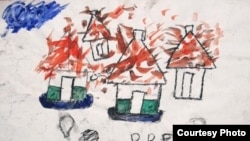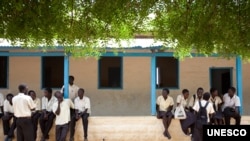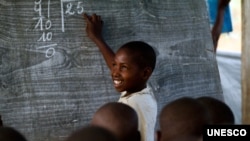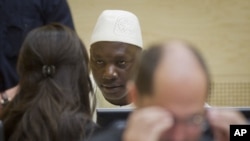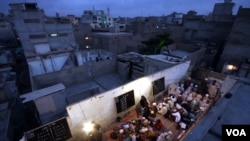Educating their children is important to most parents, including families uprooted by conflict.
UNESCO’s latest Education for All (EFA) Global Monitoring Report quotes a woman who fled Sudan’s Darfur region to neighboring Chad: “We had to leave behind all of our possessions. The only thing we could bring with us,” she said, “is what we have in our heads, what we have been taught…Education is the only thing that cannot be taken from us.”
Grassroots innovations
With that in mind, several conflict-stricken communities in Africa have taken action. They’ve started schools that today serve to up to 60,000 students in the African bush. Some improvise with boards nailed to trees and recent graduates acting as teachers.
In Afghanistan, communities have created schools in camps and abandoned buildings.
Pauline Rose is the director of the yearly report.
"Bush schools," she explained, "move around when [people] are displaced. So, [the schools] pick up whatever they have and move to hide in the bush, so it is a very flexible situation.
"[In Afghanistan] some of the community schools started as girls’ schools that were literally in people’s houses: some women would set them up with girls in the community – they would obviously need to hide away from the Taliban at that time. Then, as they became more widespread, they became more established and started to get external support. Now they have become part of the formal education system."
Rebuilding
There are other signs of progress. In Nepal, NGOs mediated between armed groups and the government to establish “zones of peace” to ensure the neutrality of school buildings and end the recruitment of children.
UNICEF has created and distributed packages of teaching materials called “schools in a box,” as well as tents that can be used as makeshift classrooms. In Gaza in 2008 and 2009, they helped keep 200,000 students in school.
In some places, UN peacekeepers have provided the protection needed to help girls stay in school. The UNESCO report says in parts of Sudan and the Democratic Republic of the Congo blue berets have accompanied women and girls as they go to school or to collect water.
It says some states -- including Ethiopia, Mozambique, Sierra Leone and Rwanda -- have made great strides in rebuilding their education systems after conflict. Rose says the four countries have common features.
"They started early on by prioritizing education," she explained. "There was high demand for education within the countries, so early on they abolished school fees, which led to a large increase in enrollment. They developed [national] education plans as part of a wider development plan, and that helped to ensure they got longer-term funding from outside sources.
" [The national plans] would include planning for funding of education: [for example], when you abolish fees [that it’s made clear] where those funds are going to come from…the expansion of school infrastructure, the increase in the number of teachers [including] how to ensure they would get training and what the longer term funding implications would be."
Over the past seven years, post-conflict South Sudan has doubled the number of students in school to 1.5 million. UNESCO credits the government for what it calls a flexible approach, using semi-permanent classrooms, tents and facilities with only roofs. The country is also using a geographic information system that allows it to pinpoint dense population pockets and determine whether they have adequate school buildings.
"In South Sudan, one of the positive things is the new government is taking education very seriously," said Rose.
" It has very quickly gone ahead and started to develop an education plan to help ensure schools are built where they are needed and that teachers are recruited and so on. The intention is to try and make sure that they can raise external funds to support the plan. Donors will be looking for some planning to make sure there is something in place that they will be able to support.
"It is still a very challenging situation. The government is still waiting to see if donors will come in with resources. But donors are still nervous because of the continued tensions and so on. Whether the country gets the support it needs is in question. "
Aid shortage
Despite progress, problems remain.
Rose says development aid, including support for education, often goes to conflict countries of importance to the West, such as Afghanistan and Pakistan.
She says only a small portion of humanitarian aid goes to education.
"There’s a bit of a paradox in the humanitarian system," said Rose. "On the one hand they say refugees are supposed to have the right to education. But at the same time humanitarian aid is seen as life-saving rather than providing support to longer term conflict situations. That means education is badly funded in humanitarian systems. Only two percent of humanitarian aid goes to education, which is a small amount.
"When appeals are put in for education funding along with other funding in humanitarian situations, education gets the least amount of what it requests. On average it gets about a third of its requests. "
The report suggests an increase in funding for education in post conflict countries. It asks donors for a boost of US $6 billion annually in their support for the multilateral Global Partnership for Education. The organization pools money from donors for strengthening educational systems, including the construction of classrooms and purchase of textbooks.
Impunity
Another lingering problem is impunity for those who commit violence against young people.
The International Criminal Court has a large list of alleged perpetrators linked to attacks on school children. Rose urges quicker prosecutions of those indicted.
She’s encouraged by the court's conviction in May of Congolese warlord Thomas Lubanga, who was found guilty of recruiting child soldiers.
"The conviction of Lubanga from DRC via the ICC," she said, "is a landmark case of finding someone guilty of recruiting child soldiers. That would hopefully send a signal to others who are also likely to be recruiting child soldiers that they can actually be caught, and there are implications for what they do -- which up until recently has not been there. It’s not just a case of having a piece of paper that says children have a right to education, but needing to have some enforcement of these laws against people who are perpetrating crimes against children, recruiting child soldiers."
International support
The EFA Global Monitoring Report also recommends the creation of an International Commission on Rape and Sexual Violence to identify people and governments involved. Its evidence would be referred directly to the International Criminal Court for investigation. The UN Security Council could also be encouraged to investigate governments that fail to tackle impunity.
The report suggests UNESCO could lead a group to monitor violence against education to investigate attacks on schools and students. And it suggests sanctions against those suspected of recruiting child soldiers or bombing schools, including travel bans and the freezing of perpetrators’ assets.
In addition, it says the UN could work with member states to develop national action plans. They would help governments comply with international protections for children and with the provision of education to young people displaced by conflict.
Development experts say there is usually only a small window after a conflict for government to stabilize the country and prevent a return to conflict. They say enrolling children in school helps convince families that stability has returned, and offers the promise of a better future to former combatants.
UNESCO’s latest Education for All (EFA) Global Monitoring Report quotes a woman who fled Sudan’s Darfur region to neighboring Chad: “We had to leave behind all of our possessions. The only thing we could bring with us,” she said, “is what we have in our heads, what we have been taught…Education is the only thing that cannot be taken from us.”
Grassroots innovations
With that in mind, several conflict-stricken communities in Africa have taken action. They’ve started schools that today serve to up to 60,000 students in the African bush. Some improvise with boards nailed to trees and recent graduates acting as teachers.
In Afghanistan, communities have created schools in camps and abandoned buildings.
Pauline Rose is the director of the yearly report.
"Bush schools," she explained, "move around when [people] are displaced. So, [the schools] pick up whatever they have and move to hide in the bush, so it is a very flexible situation.
"[In Afghanistan] some of the community schools started as girls’ schools that were literally in people’s houses: some women would set them up with girls in the community – they would obviously need to hide away from the Taliban at that time. Then, as they became more widespread, they became more established and started to get external support. Now they have become part of the formal education system."
Rebuilding
There are other signs of progress. In Nepal, NGOs mediated between armed groups and the government to establish “zones of peace” to ensure the neutrality of school buildings and end the recruitment of children.
UNICEF has created and distributed packages of teaching materials called “schools in a box,” as well as tents that can be used as makeshift classrooms. In Gaza in 2008 and 2009, they helped keep 200,000 students in school.
In some places, UN peacekeepers have provided the protection needed to help girls stay in school. The UNESCO report says in parts of Sudan and the Democratic Republic of the Congo blue berets have accompanied women and girls as they go to school or to collect water.
It says some states -- including Ethiopia, Mozambique, Sierra Leone and Rwanda -- have made great strides in rebuilding their education systems after conflict. Rose says the four countries have common features.
"They started early on by prioritizing education," she explained. "There was high demand for education within the countries, so early on they abolished school fees, which led to a large increase in enrollment. They developed [national] education plans as part of a wider development plan, and that helped to ensure they got longer-term funding from outside sources.
" [The national plans] would include planning for funding of education: [for example], when you abolish fees [that it’s made clear] where those funds are going to come from…the expansion of school infrastructure, the increase in the number of teachers [including] how to ensure they would get training and what the longer term funding implications would be."
Over the past seven years, post-conflict South Sudan has doubled the number of students in school to 1.5 million. UNESCO credits the government for what it calls a flexible approach, using semi-permanent classrooms, tents and facilities with only roofs. The country is also using a geographic information system that allows it to pinpoint dense population pockets and determine whether they have adequate school buildings.
"In South Sudan, one of the positive things is the new government is taking education very seriously," said Rose.
" It has very quickly gone ahead and started to develop an education plan to help ensure schools are built where they are needed and that teachers are recruited and so on. The intention is to try and make sure that they can raise external funds to support the plan. Donors will be looking for some planning to make sure there is something in place that they will be able to support.
"It is still a very challenging situation. The government is still waiting to see if donors will come in with resources. But donors are still nervous because of the continued tensions and so on. Whether the country gets the support it needs is in question. "
Aid shortage
Despite progress, problems remain.
Rose says development aid, including support for education, often goes to conflict countries of importance to the West, such as Afghanistan and Pakistan.
She says only a small portion of humanitarian aid goes to education.
"There’s a bit of a paradox in the humanitarian system," said Rose. "On the one hand they say refugees are supposed to have the right to education. But at the same time humanitarian aid is seen as life-saving rather than providing support to longer term conflict situations. That means education is badly funded in humanitarian systems. Only two percent of humanitarian aid goes to education, which is a small amount.
"When appeals are put in for education funding along with other funding in humanitarian situations, education gets the least amount of what it requests. On average it gets about a third of its requests. "
The report suggests an increase in funding for education in post conflict countries. It asks donors for a boost of US $6 billion annually in their support for the multilateral Global Partnership for Education. The organization pools money from donors for strengthening educational systems, including the construction of classrooms and purchase of textbooks.
Impunity
Another lingering problem is impunity for those who commit violence against young people.
The International Criminal Court has a large list of alleged perpetrators linked to attacks on school children. Rose urges quicker prosecutions of those indicted.
She’s encouraged by the court's conviction in May of Congolese warlord Thomas Lubanga, who was found guilty of recruiting child soldiers.
"The conviction of Lubanga from DRC via the ICC," she said, "is a landmark case of finding someone guilty of recruiting child soldiers. That would hopefully send a signal to others who are also likely to be recruiting child soldiers that they can actually be caught, and there are implications for what they do -- which up until recently has not been there. It’s not just a case of having a piece of paper that says children have a right to education, but needing to have some enforcement of these laws against people who are perpetrating crimes against children, recruiting child soldiers."
International support
The EFA Global Monitoring Report also recommends the creation of an International Commission on Rape and Sexual Violence to identify people and governments involved. Its evidence would be referred directly to the International Criminal Court for investigation. The UN Security Council could also be encouraged to investigate governments that fail to tackle impunity.
The report suggests UNESCO could lead a group to monitor violence against education to investigate attacks on schools and students. And it suggests sanctions against those suspected of recruiting child soldiers or bombing schools, including travel bans and the freezing of perpetrators’ assets.
In addition, it says the UN could work with member states to develop national action plans. They would help governments comply with international protections for children and with the provision of education to young people displaced by conflict.
Development experts say there is usually only a small window after a conflict for government to stabilize the country and prevent a return to conflict. They say enrolling children in school helps convince families that stability has returned, and offers the promise of a better future to former combatants.




